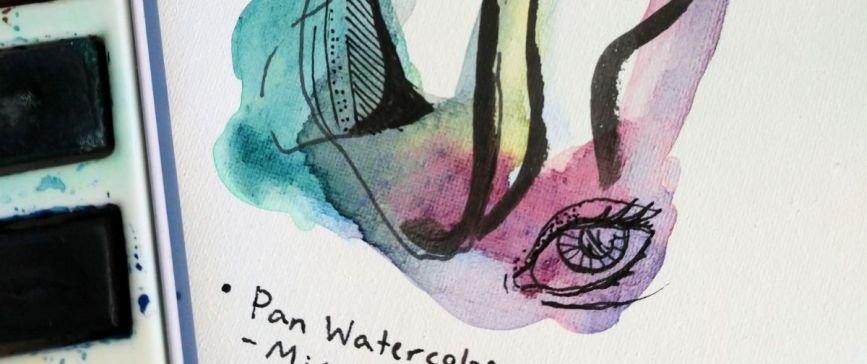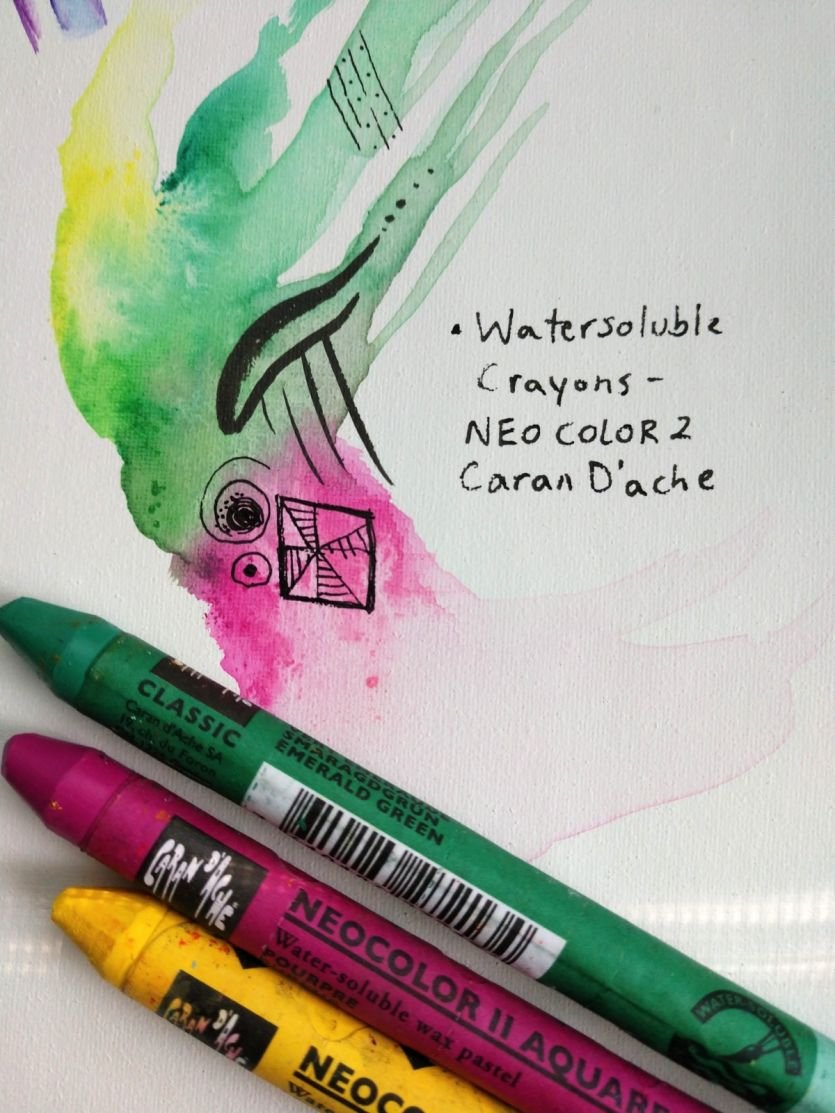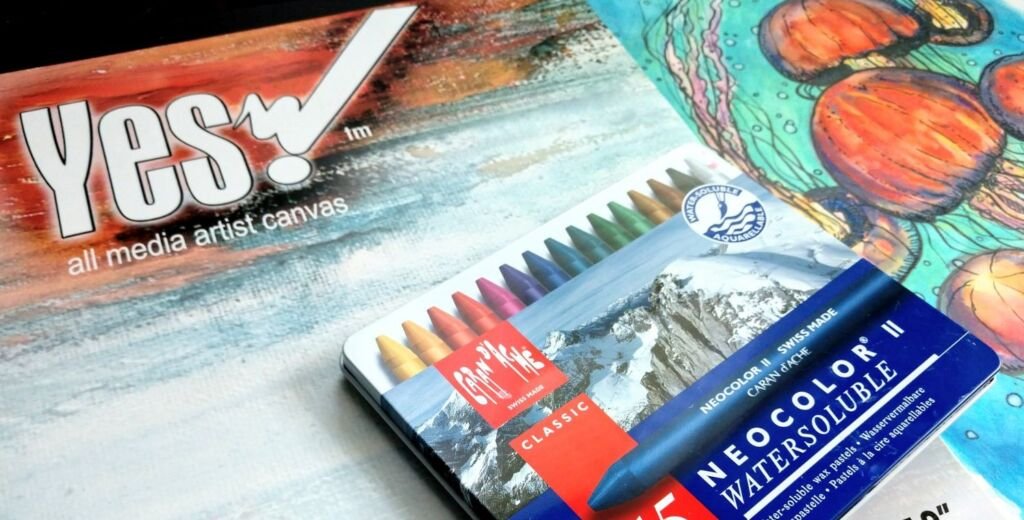
I’m always checking out art shops to find new mediums and materials to experiment with, and I recently ran across Yes! All Media Artist Canvas canvas sheet pads. The cover exclaimed that it was a “Canvas That Accepts Every Wet Media”! I love working with wet media so I bought a 9″x12″ pad and rushed home to try it out.
The Canvas Test Plan
So I love water media, but I HATE stretching paper so it doesn’t buckle. Like, totally loathe it. I’m terrible at doing it. I either forget to do it all together before starting my art, or I try it and run into endless problems. I soak it in water too long, I soak it in water too little… all the tapes I try either won’t stick on the paper or won’t stick on the surface I’m attaching it to… I normally just end up doing an after-stretch to smooth out waves in the finalized art, which I’d always like to avoid. Flattening the art after it’s made can be risky to the art itself.
I’ve tried some canvas panels in the past that claimed to be for water media in an attempt to avoid stretching paper. Unfortunately, the medium wouldn’t ever stick to the the surface or blend out. The colors just sort of sat on top in a puddle and lifted up super easily. My hope with Yes! All Media Canvas was that it would out-perform the other alternatives I’ve tried so I could skip paper stretching for some projects.
I decided to put Yes! All Media Artist Canvas to the test with a handful of my favorite wet media:
- Watercolors
- Inks
- Watersoluble crayons
- Wet Pastels
Watercolor Test
I used my Aquafine pan watercolors for the test and was pleasantly surprised with how well they worked on the paper.
They took a a little bit longer to soak into the paper than they would with say a 130lb regular watercolor paper. However, they didn’t just sit on top forever and push around like other water color canvases I’ve tried. They definitely adhered to the paper better, and I could even do some wet on wet techniques.
The canvas paper doesn’t saturate like regular paper does though. It seems like you have to control the watercolors in the directions you’d like them to go a bit more, but I achieved some decent blending.
I tried to do some scraping to lift color and found that a bit more challenging because of the textured surface.

I had a hard time getting a clear sharp line because little bits of paint remained in the small texture grooves underneath. I was able to purposely lift color with my brush pretty easily after it dried though, so that was a plus.
I also tried some pens on top of the watercolor to see how it handled layering different types of media. I used some permanent pens like Micron and Microperm, and also tried a non-permanent ink with a Copic Gasenfude pen. The ink pens layered nicely on top of the watercolor.
Water Crayon Test
I used NEO Color II water soluble crayons for the test.
Colors remained super saturated and I could add lots of layers easily. Blending was very easy.
Wet techniques worked pretty well too. Though like I mentioned with the watercolor, it’s a little harder to get the canvas really saturated compared to paper so I had to help the blending along a little.
I tested Micron pens, Microderm pens, and the non-permanent Copic Gasenfude pen on top of the crayons. I was happy to see that they drew just fine on top of the crayon.
I had similar issues with scraping techniques not working very well because pigment remained stuck in little texture grooves. Intentionally lifting color was nice and easy though.

Chalk Pastel Test
Chalk pastels are a newer medium for me, but I’m really growing to really like them. I thought I would give wet pastels a try on the all media canvas to see how they might work out.
I applied the wet pastels with a loaded brush; I got my brush wet, loaded up color from some of my pastel sticks, and put the wet pigment directly on the canvas.
The colors blended well into one another.
Pigments were easily re-blended with water. The pastels seemed to be easier to re-activate with water than the watercolors and watersoluble crayons.
The chalk pigments stayed stuck on the paper! Pastel art can be fragile and easily smeared. The wet pastels really stuck to this canvas once dry. I’m assuming the slight texture on the paper helps with that.

I didn’t really notice any chalkiness on my finger when I rubbed across the art firmly on thinner layers. I only tested with a couple of layers though. I have a suspicion that things may get a little dustier the more layers you pile on.
Something else that was very exciting was being able to use pen on top of the chalk pastels. Normally the dustiness of pastels makes direct use of marker pens on top of them impossible. However, I used Micron pens, Microderm pens, and the Copic Gasenfude just fine on top of the layers I did. I’ll have to test how well the pens still work on thick pastel layers in the future.
Test Results:


Thumbs Up:
- The quality of the cotton for the canvas itself is sturdy and smooth.
- Canvas sheets can be rolled up into a tube for easy mailing.
- The surface primer is strong and didn’t wear down as I did art on it.
- The surface primer is relatively smooth but still has a little bit of tooth and texture for media to stick to.
- Layering color was easy.
- Wet on wet blending was doable.
- The texture of the paper showed through the paint a bit which I liked.
- Paint lifting techniques worked well because the canvas surface doesn’t seem to stain as easily as a regular paper might.
- The paint was well-adhered to the surface once dry– there was no flake off.
- Thin layers of wet chalk pastels didn’t rub off after drying.
- Was able to use ink pens directly on top of thin layers of dried water pastel.
- Because it’s canvas, you don’t have to stretch it before using water media! 😀
Challenges:
- Scraping techniques didn’t work well for me.
- Water seemed to take a little longer to soak into the canvas surface than with regular paper, but depending on what you’re trying to achieve, this could also be a positive.
- Pens tend to take longer to dry on this canvas than they do on regular papers I’ve tried. This is something to watch out for for permanent ink pens. They can smear easily if you’re not careful. You have to wait until they are completely dry before adding any water near them if you don’t want to mess up your lines.
Overall, I was really impressed with Yes! All Media Artist Canvas. It physically feels well-made and has a primer that has some nice absorbancy. It performed circles around competitor watercolor boards I’ve tried. It also has just the right amount of texture on it to hold things in place but still allow for traditional drawing media like pens to work pretty smoothly on it.
I’m particularly excited about its potential with wet pastel techniques. It seems to really help on cutting down the chalkiness and seems to help make the artwork a little less fragile and prone to smearing.
Want to try it out for yourself? I personally found mine at Jerry’s Artarama. You can buy the canvas sheets I used here, try out Yes! panels here, or Yes! stretched canvases here. You can also find them on Amazon.
Have you tried Yes! All Media Artist Canvas? Let me know what your experiences were!


